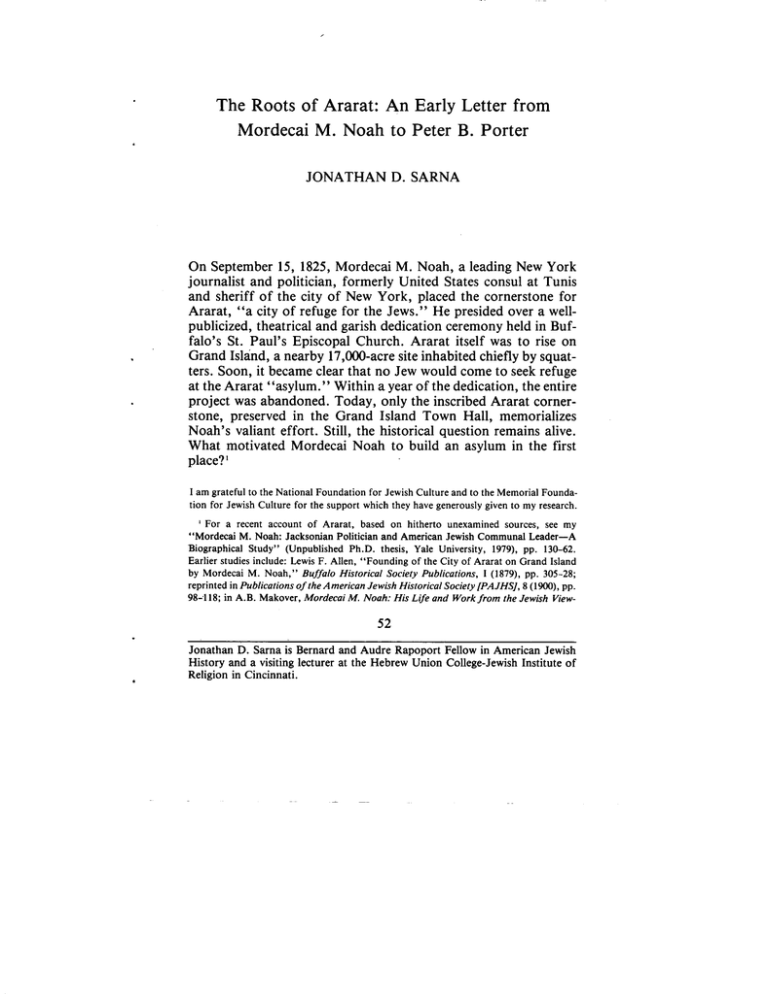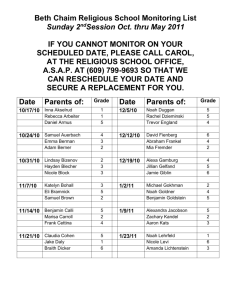The Roots of Ararat: An Early Letter ... Mordecai M. Noah to Peter B. ...
advertisement

The Roots of Ararat: An Early Letter from Mordecai M. Noah to Peter B. Porter JONATHAN D. SARNA On September 15, 1825, Mordecai M. Noah, a leading New York journalist and politician, formerly United States consul at Tunis and sheriff of the city of New York, placed the cornerstone for Ararat, "a city of refuge for the Jews." He presided over a wellpublicized, theatrical and garish dedication ceremony held in Buffalo's St. Paul's Episcopal Church. Ararat itself was to rise on Grand Island, a nearby 17 ,000-acre site inhabited chiefly by squatters. Soon, it became clear that no Jew would come to seek refuge at the Ararat "asylum." Within a year of the dedication, the entire project was abandoned. Today, only the inscribed Ararat cornerstone, preserved in the Grand Island Town Hall, memorializes Noah's valiant effort. Still, the historical question remains alive. What motivated Mordecai Noah to build an asylum in the first place? 1 I am grateful to the National Foundation for Jewish Culture and to the Memorial Foundation for Jewish Culture for the support which they have generously given to my research. ' For a recent account of Ararat, based on hitherto unexamined sources, see my "Mordecai M. Noah: Jacksonian Politician and American Jewish Communal Leader-A Biographical Study" (Unpublished Ph.D. thesis, Yale University, 1979), pp. 130-62. Earlier studies include: Lewis F. Allen, "Founding of the City of Ararat on Grand Island by Mordecai M. Noah," Buffalo Historical Society Publications, I (1879), pp. 305-28; reprinted in Publications of the American Jewish Historical Society [PAJHS}, 8 (1900), pp. 98--!18; in A.B. Makover, Mordecai M. Noah: His Life and Work from the Jewish View- 52 Jonathan D. Sarna is Bernard and Audre Rapoport Fellow in American Jewish History and a visiting lecturer at the Hebrew Union College-Jewish Institute of Religion in Cincinnati. Mordecai Manuel Noah (1785-1851) Early American Jewish leader and creator of the Ararat Plan ROOTS OF ARARAT 53 From Noah's day onward two conflicting interpretations of Ararat have vied for support. On one side are Noah's champions who claim that Ararat stemmed from their hero's deep and abiding concern for the Jewish people. These students see Ararat as a proto-Zionist plan, or as a response to Christian missionary efforts. They take Noah at his word when he said that he sought to ameliorate the condition of his people suffering in the Diaspora. A contrary interpretation is put forward by Noah's critics. They see Ararat as a "get-rich-quick" scheme, or what the contemporary Niles' Weekly Register called "a very great business indeed." 2 Altruism, according to this more cynical interpretation, was merely a cover for a potentially lucrative investment. Until now, both Noah's supporters and his opponents have been forced to base their arguments primarily on Noah's published writings, and on the important history of Ararat written by Noah's friend, Lewis Allen. The newly discovered letter that follows sheds fresh light on this entire question, and demonstrates that Noah's motives-at least those which he revealed to a potential investor-were mixed. Noah wanted both to offer the Jewish people "a happy and safe asylum," and to realize "a princely fortune." point (New York, 1917), pp. 36-64; and with new matter in Buffalo Historical Society Publications, 25 (1921), pp. 113-44; Max J. Kohler, "Some Early American Zionist Projects," PAJHS 8 (1900), pp. 75-118; Isaac Goldberg, Major Noah: American Jewish Pioneer (Philadelphia, 1938), pp. 189-215; Lee M. Friedman, "Ararat-A City of Refuge for the Jews," Jewish Pioneers and Patriots (Philadelphia, 1942), pp. 107-15; Robert Gordis, "Mordecai Manuel Noah: A Centenary Evaluation," PAJHS 41 (1951], pp. 1-25; Bernard D. Weinryb, "Noah's Ararat Jewish State in its Historical Setting," PAJHS, 43 (1954), pp. 170-91; Nathan M. Gelber, "Mordecai Emanuel Noah: His Dream of a Jewish State in America," SURA: Israeli-American Annual (ed. Samuel K. Mirsky), 3 (1957-58), 377-413; Selig Adler and Thomas E. Connolly, From Ararat to Suburbia: The History of the Jewish Community of Buffalo (Philadelphia, 1960), pp. 5-10; S. Joshua Kohn, "Mordecai Manuel Noah's Ararat Project and the Missionaries," American Jewish Historical Quarterly (AJHQ), 55 (December, 1955), pp. 162-98; idem, "New Light on Mordecai Manuel Noah's Ararat Project," AJHQ, 59 (December, 1969), pp. 210-14; and Louis Ruchames, "M.M. Noah and Early American Zionism," AJHQ, 64 (March, 1975), pp. 195-223. 'Niles' Weekly Register, 29 (October I, 1825), 69, reprinted in Joseph L. Blau and Salo W. Baron (eds.), The Jews of the United States 1790-1840: A Documentary History (New York, 1963), vol. III, p. 902. See also Isaac M. Fein, "Niles' Weekly Register on the Jews," PAJHS, SO (1960), pp. 3-22. 54 AMERICAN JEWISH ARCHIVES, APRIL, 1980 He saw the two goals as complementary. He felt sure that his fellow Jews would agree. The investor whom Noah wished to interest in Ararat was Peter B. Porter, a hero of the War of 1812, a New York politician, and a resident of Black Rock, New York. Porter also served as American Secretary of War, but that came later (1828-29). In 1824, Porter was investing heavily in land surrounding the soon-to-be-completed Erie Canal-especially at Black Rock where he hoped that the canal would terminate. 3 Noah, who had been contemplating his asylum plan for some years, had discussed his Grand Island scheme with Porter on previous occasions. He thought that Porter would find the investment attractive. But he had apparently misconstrued Porter's earlier expressions of interest. One month after inviting Porter to invest in Grand Island, Noah addressed him in a follow-up letter: "I ... wait impatiently for your reply." There is no record of Porter ever having responded to Noah. The general played no part at all in the subsequent Ararat purchase. His sole connection with the project came later, when he accorded the Ararat cornerstone a temporary home on his property. 4 But if Porter's role in Ararat is insignificant, his role in aiding our understanding of Ararat is great. The Noah letter preserved in his papers reveals many hitherto unknown aspects of the original Ararat program as it existed in Noah's mind. Noah disclosed in his letter to Porter that he hoped to call together a "Sanhedrin" on his colony, a seventy-member court "in which the affairs of the Jewish nation will be principally discussed." He likely hoped to further the work of Napoleon Bonaparte, who in 1806-07 had called together a Sanhedrin in Paris to promulgate new laws for the Jewish people. 5 He also planned to name his colony "Jerusalem," a designation which might have ' On Peter B. Porter, see Julius W. Pratt, "Porter, Peter Buell," Dictionary of American Biography, 15 (1935), pp. 99-100. ' Lewis F. Allen, "The Story of the Tablet of the City of Ararat," Buffalo Historical Society Publications, 25 (1921), p. 135; Lewis F. Allen to Peter B. Porter (May 22, 1834), item X-5, Peter B. Porter Papers, Buffalo and Erie County Historical Society (also on microfilm). 'The most recent account of the Paris Sanhedrin is found in Franz Kobler, Napoleon and the Jews (New York, 1975), pp. 150-74, cf. 190-95. ROOTS OF ARARAT 55 symbolized to some the idea of "Zion in America." 6 By finally settling on the name "Ararat," a place which in the Bible served as only a temporary resting spot, he evoked another image entirely. 7 Finally, Noah's letter reveals that American Jews considered a colony "objectionable from the fear that the conduct of Jewish emigrants might possibly bring them into disrepute." Perhaps American Jews opposed his plan for other reasons as well, but Noah had decided in advance to ignore the scruples of his Jewish countrymen. Convinced as he was that among European Jews his project met with favor, he determined to press on ahead. Noah's letter to Peter Porter does not invalidate previous interpretations of Ararat. Nor does it answer fundamental questions connected with the subsequent Ararat dedication, proclamation and address. But it is the best source that we have on the early motivations and goals of the project. And it is one of the most important Mordecai Noah letters that has ever come to light. New York 17 Augst. 1824 Dear General, You have several times expressed to me an interest, which I am certain you feel, in my project of offering an asylum to the Jews on Grand Island. No man is a prophet in his own Country, and as Marshall Turenne8 said in reference to domestic opinions, "no man is great in presence of his valet." Among my brethren in the United States (with all of whom I stand well) the project, though not considered visionary, is nevertheless objectionable from the • Elkanah Watson, History of the Rise and Progress of the Western Canals (New York, 1820), p. 104, called the colony "New Jerusalem." The same name is found in Benjamin Hart to Moses Hart (May 4, 1820), Hart Family Papers, file J-E-6/2 microfilm 9J6, American Jewish Archives. ,, ' Noah probably decided on the name "Ararat" for two other reasons as well. In the Bible, Noah and Ararat were intimately connected-Ararat was the resting place Qf Noah's ark (Genesis 8:4). Noah also knew of a tradition linking Ararat to Arzareth, th~ home of the "lost ten tribes" (IV Ezra 13:45). Since he associated the tribes with the Indians, and saw America as their home, Ararat was an obvious name for his colony. See on this point Noah's comments in Sunday Times and Noah's Weekly Messenger (March 3, 1'850), p. 2. ' Marshal Henri Turenne (1611-1675) was one of France's most brilliant miliiiuy commanders. Many wise sayings were attributed to him. See Maxime Weygand, Ture~n~: Marshal of France (Boston, 1930). ,, , 56 AMERICAN JEWISH ARCHIVES, APRIL, 1980 fear that the conduct of Jewish emigrants might possibly bring them into disrepute. But in Europe it has created intense anxiety which has led to an important correspondence, 9 and there my project & myself occupy a more important space in public opinion than at least I merit-and the public stations which I have held have contributed to give weight and importance to my views. Grand Island is to be sold, probably in November next, as a person left Albany lately to survey and value it. I have been looking about for a suitable person to unite with in the successful prosecution of my project. Your residence in that neighborhood, your knowledge of the Country and its resources, the desire you must feel to bring a wealthy & enterprising but persecuted people in that hospitable & flourishing Country, our knowledge of each other, and the character you sustain among us-all these considerations make it desirable that you should if consistent with your views embark with me in this laudable & prosperous project. Briefly, if I succeed in making purchase of the whole, or part of Grand Island, I contemplate calling together a number of our people, sufficiently numerous to form on that spot a Sanhedrin of seventy members, in which the affairs of the Jewish Nation will be principally discussed. We shall then lay the foundation stone, on a suitable spot, of a city to be called Jerusalem, in which we shall be assisted by the Grand Lodge of the State & all the military aid in the Neighborhood to produce abroad the conviction that the project is sanctioned by the people. It is then my intention to have the city laid off in Lots & Squares, with suitable field books, handsome views of the island, of Buffalo, Black Rock & [the] neighborhood. The Legislature, at the ensuing Session, will pass a Law confirming a title to certain limited portions of Land to any alien who may 'Noah was probably referring to a letter he received in 1822 from members of Germany's Vereinfiir Cultur und Wissenschaft der Juden. Not knowing that the authors of the letter were only in their twenties, he assumed that it represented the European Jewish mandate which he had long been seeking. The letter is reprinted in Blau and Baron, Jews of the United States: A Documentary History, vol. III, pp. 891-93. See also: Hans G. Reissner, "Ganstown-U.S.A.: A German Jewish Dream," American Jewish Archives, 14 (April, 1962), 20-31; idem, Eduard Gans: Ein Leben im Vormaerz (Tuebingen, 1965), 83-102; and Michael A. Meyer, The Origins of the Modern Jew (Detroit, 1967), 169, 179. ROOTS OF ARARAT 57 purchase abroad. Thus fortified with the approbation of the people, the sanction of the Legislature, & the security of title supported by strong personal claims, & in all probability endorsed by the General Government, I propose going to Europe, and calling together the important & wealthy portion of the Jewish people. I contemplate spreading my plans before them & inducing the younger portion of the population to purchase & emigrate. The Island may contain about 17,000 acres, & may possibly bring $50,000. 10 Out of the purchase money, $6,000 only will be required; for the remainding part any credit can be obtained from the State. In laying off a City to contain 1,000 acres, divided into 1,000 building Lots, I shall have no difficulty in disposing of these 1,000 Lots, free of taxes for five years, at $100 each lot. And such will be the pressure and anxiety in Europe to obtain a lot of undisputed title that the whole Island can be disposed of with ease at an immense profit; thus offering a happy & safe asylum to our people, and at the same time-by & with their approbation & consentrealising a princely fortune. One impediment alone exists, namely want of present means. To realise the purchase of that Island, to pay the Eight[h] of the total amount as required by Law, & to pay incidental expenses of a voyage to Europe, the small investment of $10,000 only would be required. And if you are inclined to join me in this project, I will freely divide all the advantages which must grow out of it. I shall communicate more at large with you, on the receipt of your answer. Very sincerely & truly yours M.M. Noah 11 Dear General I wrote a long letter to you some time ago respecting Grand Land speculators inflated the price of Grand Island. According to the Black Rock Gazette (June 21, 1825), p. 3, New York State sold the land for $76,230. 11 The original of this letter is found in the Peter B. Porter Papers, item HH-26, Buffalo and Erie County Historical Society (punctuation modernized). I am grateful to the Society for permitting me to publish this item. 10 58 AMERICAN JEWISH ARCHIVES, APRIL, 1980 Island & wait impatiently for your reply. Favour me with a few lines as there are several persons desirous of embarking with me in the undertaking. Very truly yours M.M. Noah 12 New York 13 Sept 1824 " The original of this letter is found in the Norton Collection of the Buffalo and Erie County Public Library. I am grateful to the Library for permitting me to publish this item.




